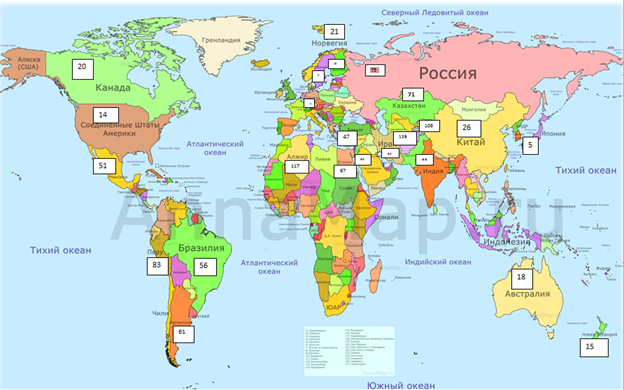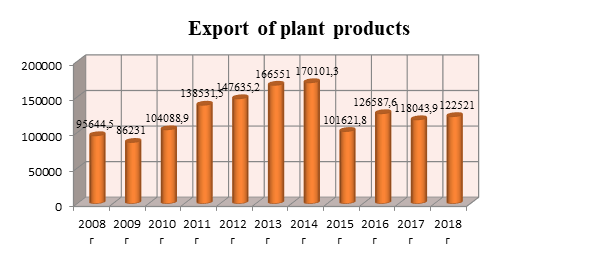
The development of agriculture in the Kyrgyz Republic is one of the priority areas of the Kyrgyz economy. This industry provides 1/5 of GDP and 50% of employment. More than 60% of the country's population lives in rural areas, and they all need to work. Therefore, the growth of the economy and the well-being of the country's citizens depend on the development of agriculture. The current state of agriculture does not meet the requirements of the existing market. The agrarian industry today remains ineffective and low-profit, has many unsolved problems. Livestock productivity and crop yields remain very low. Insufficiency and deterioration of equipment, lack of seed production, neglect of the irrigation system and other problems of the agricultural sector in Kyrgyzstan remain unresolved.
Let's highlight the main problems of the agro-industrial sector that require urgent solutions:
- Small-scale production. There are over 400 thousand small farms (peasant farms) that own small land plots. This fragmentation does not allow the accumulation of powerful production potential.
- There is an acute lack of support from the state, state subsidies for irrigation of lands, plant protection, veterinary medicine, preservation and improvement of soil fertility, etc.
- There is not enough agricultural machinery.
- The need for plant protection products, mineral and organic fertilizers.
- Difficulties in selling products. Numerous intermediary organizations between agricultural producers and sales markets, which generate significant income, mainly by infringing on the interests of farmers.
- Certification. The underdevelopment of a product certification system that meets international standards is becoming a serious barrier to the export and development of agricultural products processing.
- Decrease in soil fertility, ineffective use of land and water resources;
- Lack of water resources. Losses of water from irrigation of land are almost 30% annually.
- Integration of Kyrgyzstan into the EAEU and the impact of market globalization.
It is impossible to solve all the problems at the same time, but in this article we want to draw attention to how, using logistic principles, it is possible to solve the problems associated with the export of agricultural products to the EAEU countries [2].
The lack of logistics has an extremely negative impact on the development of the country's economy and trade. This statement was made by Denny Cho, professor at the Wharton School of Business at the University of Pennsylvania (USA), at an international conference on logistics and supply chain management with the participation of international experts in transport and infrastructure of the Kyrgyz Republic. "There are many problems in the logistics of Kyrgyzstan, one of the most important is the development of infrastructure." The professor, in particular, noted the existing unresolved problems in customs clearance and in the export of goods. “Naturally, you must first understand the essence of the problems. The population still lacks the concept of logistics itself. It is necessary that as many people in business and in government as possible understand how to develop logistics [1], - he explained his idea.
The efficiency of Logistics worldwide is assessed by the Logistics Performance Index (LPI) on a five-point scale, with the lowest score being 1, the highest - 5.
The index assesses six main factors: efficiency of the customs authorities; infrastructure; ease of organizing international supplies of goods; competence in logistics; the ability to track goods throughout the supply chain; adherence to delivery times [8].
Kyrgyzstan ranks 108th out of 160 possible in the world ranking of trade logistics (the index corresponds to 2.55 points).

Figure 1. The distribution of the Logistics Performance Index (LPI) for 2018 all over the world
As shown 0n the fig. 1, the following 5 countries occupy the highest position in the Logistics Performance Index according to the World Bank for 2018: Germany - 1st place; Sweden - 2; Belgium - 3; Austria - 4; Japan - 5th place. Such major powers as the United States are in 14th place; China is in 26th place.
It should also be noted how the places in the rating of our closest partner countries are located: Kazakhstan -71; Russia -75; Uzbekistan - 99; Belarus - 103; Kyrgyzstan - 108th place; Turkmenistan - 126th place; Tajikistan -134 place [6].
As a rule, the bottom lines in the ranking are occupied by countries with a low income level, landlocked or countries where conflicts occur [5].

Figure 2. Dynamics of exports of plant products for the period 2008-2018 [4]
Considering the dynamics of the export of plant products of the Kyrgyz Republic over the past 10 years, reflected on the fig. 2, one can observe a steady growth in the export of plant products from 2010 to 2014. Export indicators in 2014 are 2 times higher than in 2009. However, in 2015, with the accession of Kyrgyzstan to the EAEU, there is a significant decline in exports by 40.2%. Over the next three years, there has been a slight increase in exports. The figures for 2018 are below the highest export growth rate in 2014 by 28%.
To achieve the set goals, namely the well-being of the agricultural sector, it is necessary to improve the state regulatory policy. In particular, legal and financial-credit relations, regulation of agricultural production, its purchase and processing, the introduction of new technologies, as well as the creation and expansion of logistics centers in all regions of the country [7].
To implement these measures, a state resolution for 2015-2017 was introduced. for the construction and expansion of logistics and agricultural trade centers. This policy should develop this sector and strengthen its export potential.
Logistic centers began to be created where the harvested crop can be stored in special storage facilities. They meet the most modern requirements and standards. Similar storage facilities will be opened in all regions of Kyrgyzstan, where the grown crops will be stored with the least loss.
The Ministry of Agriculture, Food Industry and Land Reclamation of the Kyrgyz Republic has submitted for public discussion a draft government decree “On approval of the Program for the Development and Increase of the Export Potential of Organic Agricultural Products of the Kyrgyz Republic for 2019-2023” [3]. The project was designed to develop and increase the country's export potential. Conditions are being created to ensure the availability of fresh farms for processing and export (seeds and seedlings) to modern technologies, methods, varieties, organization of the construction of storage warehouses, modern processing lines, creation of ubiquitous access to organic fertilizers, agricultural materials and agricultural machinery. It also provides for guaranteed sales of organic products in foreign markets at a high price.
The EAEU provides common standards and rules for trade in one territory, but in a competitive environment. To receive benefits, it is necessary to have state institutions for the development and maintenance of the rules of the game.
Summing up, we can say that in order to bring the efficiency of logistics to the proper level, our country needs to improve its infrastructure, customs system, simplify transportation and trade procedures, expand professional skills for the introduction of modern services, improve the regulatory framework for expanding logistics centers in all regions of the country.
List of used literature
1. Denny Cho, professor at the University of Wharton School of Business Pennsylvania (USA). Materials of the international conference on Logistics and Supply Chain Management with the participation of international experts in transport and infrastructure of the Kyrgyz Republic. Bishkek. Feb 2016
2. Kizdarbekova M.Zh. Problems and prospects for the development of logistics in Kazakhstan [Text]: Young scientist. - 2017. - No. 14. - S. 363-365.
3. Program for the development and increase of the export potential of organic agricultural products of the Kyrgyz Republic for 2019-2023.
4. Export of goods by sections. Statistical Book. Bishkek: National Statistical Committee of the Kyrgyz Republic, 2019.
5. Aggregated LPI 2012-2018 [Electronic resource]. - Access mode: https://lpi.worldbank.org/international/aggregated-ranking
6. Logistics efficiency index: the gap remains [Electronic resource]. - Access mode: : http://www.vsemirnyjbank.org/ru/news/press-release/2014/03/20/logistics-performance-index-gap-persists
7. Indina M. The Ministry of Agriculture of Kyrgyzstan promises to solve problems in agriculture for 9 billion soms [Electronic resource]. - Access mode: https://knews.kg/2017/01/11/minselhoz-kyrgyzstana-obeshhaet-reshit-problemy-v-selskom-hozyajstve-za-9-mlrd-somov
8. Umetaliev A.S., Dolotbakova A.K., Kydykov A.A. Efficiency of logistics in Kyrgyzstan [Electronic resource]. - Access mode: http://ran-nauka.ru/wp-content/uploads/2014/09/Nauka-8-2017.pdf